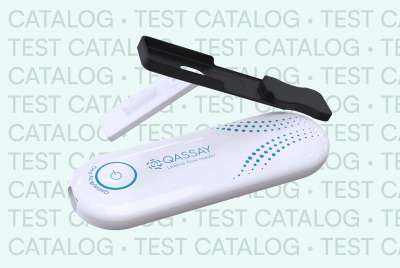Serological rapid diagnostic tests (RDTs) are widely used across pathologies due to their ability to provide users with a simple, binary result (positive or negative). This type of test has first been developed in the early 70s and has mostly been used to determine pregnancy status for more than three decades.
Over the years, the applications of RDTs have expanded considerably, and nowadays we have tests for a variety of pathogens and analytes, making them invaluable tools for diagnosis and health management. However, reading and processing test results manually used to come with some limitations, which are currently being overcome through the use of math models.
What are serological rapid diagnostic tests and how do they work?
Serological rapid tests detect antibodies in human fluid samples, producing a binary test result (positive or negative) in a relatively short time (5 to 20 minutes). They can be used to diagnose an active or previous infection or to identify autoimmune disorders.
Rapid tests are diagnostic assays adapted for use in low-resource settings or designed for use at the point-of-care (PoC). They are stable at high temperatures, simple to operate and read, and inexpensive.
Rapid tests or immunoassays detect disease using the principle of antigen-antibody reaction and can determine both the presence and concentration of an analyte. In other words, specific antigens stimulate unique immune responses, and the proteins produced by the immune response, called antibodies, indicate the presence of a target compound in a sample.
The most common type of rapid tests is the lateral flow device, a paper-based platform which works by applying a fluid sample at the end of the test strip and waiting for the sample to flow due to capillary action to the other end of the strip or the absorbent pad. The liquid sample contains an analyte which binds to the capture reagents of conjugates and on the membrane. The conjugate release pad contains antibodies specific to the target analyte; the sample, together with the conjugated antibody bound to the target analyte, migrates along the strip into the detection zone. This area contains specific antibodies or antigens immobilized in lines and which react with the analyte bound to the conjugated antibody.
Recognition of the sample analyte produces a response on the test line, while the response of the control line indicates the liquid has flown properly through the strip.
The test line works differently in sandwich assays and competitive assays. In the first type of assay, described above, the darker the test line, the higher the concentration of the analyte. In competitive assays, the absence of the test line is an indicator of analyte presence.
Limitations that existed before in rapid tests
The simplicity of rapid diagnostic tests does not mean, however, that results are easy to read or reliable. This is happening for several reasons:
- The aspect of the test lines can differ from one brand and/or test model to others;
- Low antibody levels can produce test lines that are not easily distinguished, causing positive tests to be read as negative;
- Subjectivity of the reader and vision limitations can also impact the reading of the test result;
- PoC tests such as lateral flow immuno-assays can be performed with minimal training and equipment but are less sensitive compared to tests conducted in reference labs;
- Data regarding test results could only be collected and processed manually, a task which is time-consuming and susceptible to human error.
In short, two major improvements were necessary: finding a way to eliminate subjectivity and human reader limitations from test result reading and collecting and processing test result data more effectively. The adoption of digital readers combined with artificial intelligence software has changed the way rapid diagnostic test results are being processed, leading to rapid and personalized responses to diagnosis and opening a new horizon for research and scientific discovery.
Improvements made to rapid diagnostic test result interpretation
The two improvement directions needed to maximize the value of RDTs have been developed by implementing the following advanced technologies:
Reader apps
Smartphone apps for reading rapid test results use machine learning to classify serological test results and reduce reading ambiguities. Such apps yield more than 99% precision, compared to reading by eye, which produces an accuracy of a little over 90%. Additionally, reading apps enable traceability to provide a clearer diagnosis. The use of reader apps increases the confidence of clinical staff and creates opportunities for more accurate patient self-testing.
Because the intensity of the test line depends on the quantity of antibodies present in the sample, smartphone apps combine the high-resolution imaging abilities of the smartphone’s camera with image treatment to read and interpret rapid diagnostic test results.
Reader devices
Lateral Flow readers like the ones produced by Qassay® are another effective, less costly solution for reading rapid test results correctly. For example our Multi-use (LFT) reader, supplied in kit form with multiple disposable test strips.
Qassay® (by P4Q) Rapid, Digital Lateral Flow Test Readers are based on High-Precision Multi-Spectral Sensor Technology, highly accessible, supporting medical diagnostics , enabling them to evaluate any lateral flow strip test with higher accuracy, in terms of quantitative and qualitative analysis.
Storing test results into the cloud
Whether test results are being read using a smartphone app or a dedicated reader device, the raw data is automatically synchronized and stored in the cloud. Cloud infrastructure provides secure storage and access to data, and the use of proprietary cloud platforms simplifies regulatory implications for users.
Qassay® uses the trust-test cloud platform- development of its own website (www.trust-test.com) – based on AWS., which offers test data classification and analyses with machine learning capabilities. Our in-house data security (security of data in transit and at rest) comes with multiple data management options, using the latest encryption methods to ensure optimum security and patient privacy at the highest standards. Additionally, this allows us to have third-party auditors assess the security and compliance of the services as part of various AWS compliance programs, such as SOC, PCI, FedRAMP, and HIPAA.
The use of different algorithms makes it possible to obtain precise and reliable diagnoses. Next, the platform offers test mapping capabilities to help with prevalence map analysis procedures, leading to quick reactions to epidemic threats. Local leaders are empowered to make decisions to keep the population safe, while sharing data securely across a global network of organizations.
Using Math Models to process test results
As seen in the previous section, the next logical step after collecting and storing data is to use it for analysis to make better decisions. The last years have brought an increased focus on the role of artificial intelligence and big data in diagnostics. The development of data management in the lateral flow test market has implications for human health but also for animal health and welfare and for agricultural and environmental applications.
Lateral flow test results can be collected anywhere, and the information is communicated to a central source for further processing and analysis using Math models. One of the areas benefiting from Math models in test result analysis is the connected farm. Cloud-based data management can allow real-time monitoring of disease outbreaks, making it possible to take preventative measures to restrict the spread of the outbreak. Combined with other factors such as temperature and humidity, test result information can even be used to create early warning mechanisms to prevent future outbreaks.
Through the use of cloud storage and Math models data management, lateral flow diagnostic tests become more than standalone devices and are integrated within a data capture solution with higher applicability across the diagnostics market. Replacing traditional databases with cloud data storage makes data reporting procedures faster and more accurate, helping to prevent the spread of disease. Medical experts and anyone with a role in managing disease can have access to real-time data instead of waiting for data to come from different areas and be uploaded.
The use of Math models in conjunction with rapid tests during the Covid-19 pandemic
The rapid evolution of the COVID-19 pandemic has been a factor in developing new rapid diagnostic tests for identifying SARS-CoV-2. As of June 2020, more than 176 SARS-CoV-2 serological RDTs had been developed. These rapid diagnostic tests have been used in health facilities and in drive-through testing centers, which has made it possible to test large populations with minimal training and to collect data to make shutdown and reopening procedures when necessary.
The utilization of a smartphone app (xRCovid) that uses machine learning to classify SARS-CoV-2 serological RDT results and reduce reading ambiguities has led to a 99.3% precision across 11 Covid-19 rapid diagnosis test models, also enabling traceability to ensure a clearer diagnosis.
Implications of using Math Models to improve test result interpretation
Rapid diagnostic technology combined with artificial intelligence and machine learning represent the start of a new era in diagnostics and outbreak management by ensuring the following benefits:
- Eliminating human error and subjectivity from test results to ensure impartial test analysis;
- Allowing for predictive values of each test as the test results are updated in real time;
- Preventing supply shortages by using predictive analysis to determine the future need for critical equipment and reduce waste in the supply chain;
- Producing live disease maps by offering access to test results to health authorities using anonymized location data;
- Benefiting patients from low- and middle-income settings by providing affordable and accurate rapid diagnostic tests;
- Making other types of tests, such as agglutination tests, more suitable for self-testing through the use of deep-learning algorithms that can read more accurately blood spots with and without apparent agglutination;
- Managing more efficiently large amounts of patient information, streamlining workplace practices and sharing information safely and with unprecedented ease;
- Accomplishing the de-identification of patient data in order to ensure the privacy. De-identification is the process of removing identifying information from patient data and is critical for sharing health information with third parties for research purposes and use in advanced analytics and machine learning models. Moreover, data can be safely re-identified when needed, allowing researchers to effectively recruit for public health programs and accelerate discovery.
- Potentially making it possible to identify viruses in seconds.
Regarding to the last benefit, an Oxford university spin out company is currently developing tech to identify viruses in seconds. As of February 2022, OxDX had raised £2.6m in pre-seed funding for its Math models powered diagnostic technology. The new method is expected to recognize and identify specific species and strains of viruses, bacteria and other pathogens in a sample within seconds. Initial partners of this project are IQ Capital and Ahren Innovation Capital, with participation from Science Creates Ventures to expand the team and attract additional development partners in the future.
Alex Batchelor, chief executive officer of OxDX, declared: “We’ll start with respiratory viruses and expand from there. In parallel, we’ll be simplifying the workflow to move the test from the lab to point of care, which will represent a step change in the availability and cost of infectious disease diagnostics worldwide.”
The use of new technologies designed to read and store the results of rapid diagnostic tests, such as reading devices, cloud storage, and latest tech-powered analysis maximizes the potential of lateral flow tests and other rapid, self-assessed tests. As a result, health experts and persons administering rapid tests enjoy advantages such as increased accuracy, predictive value, and more effective outbreak management.





